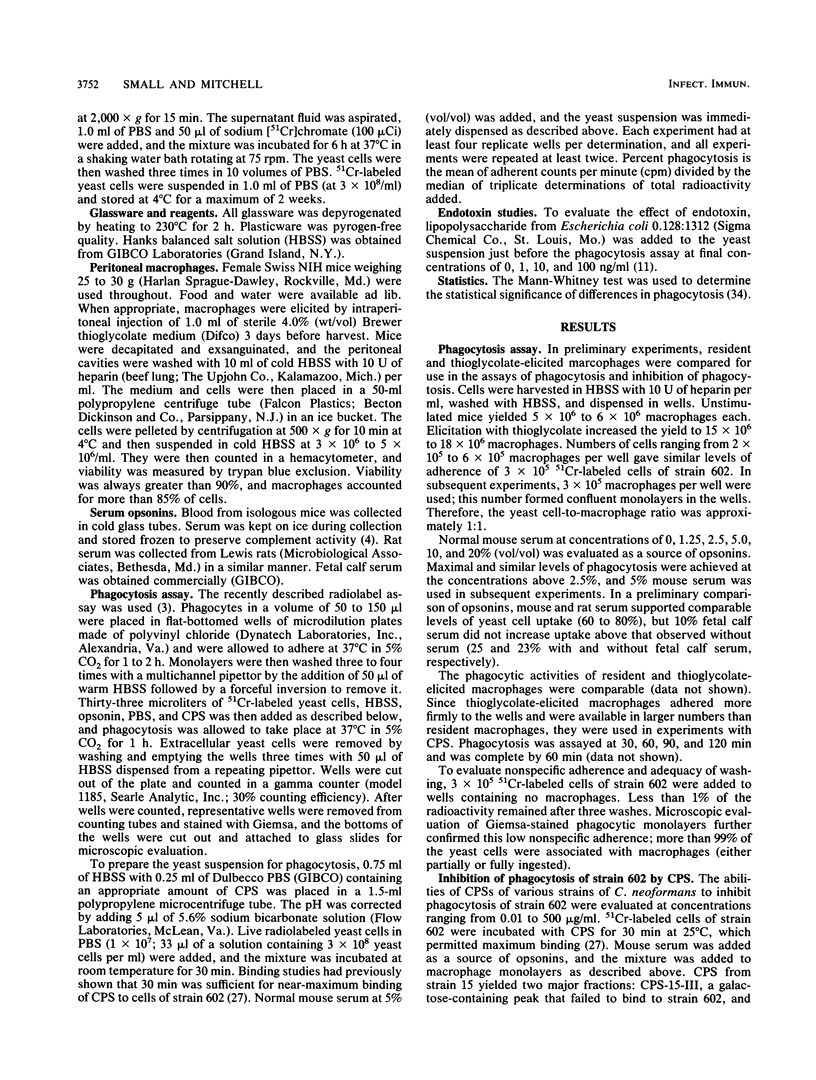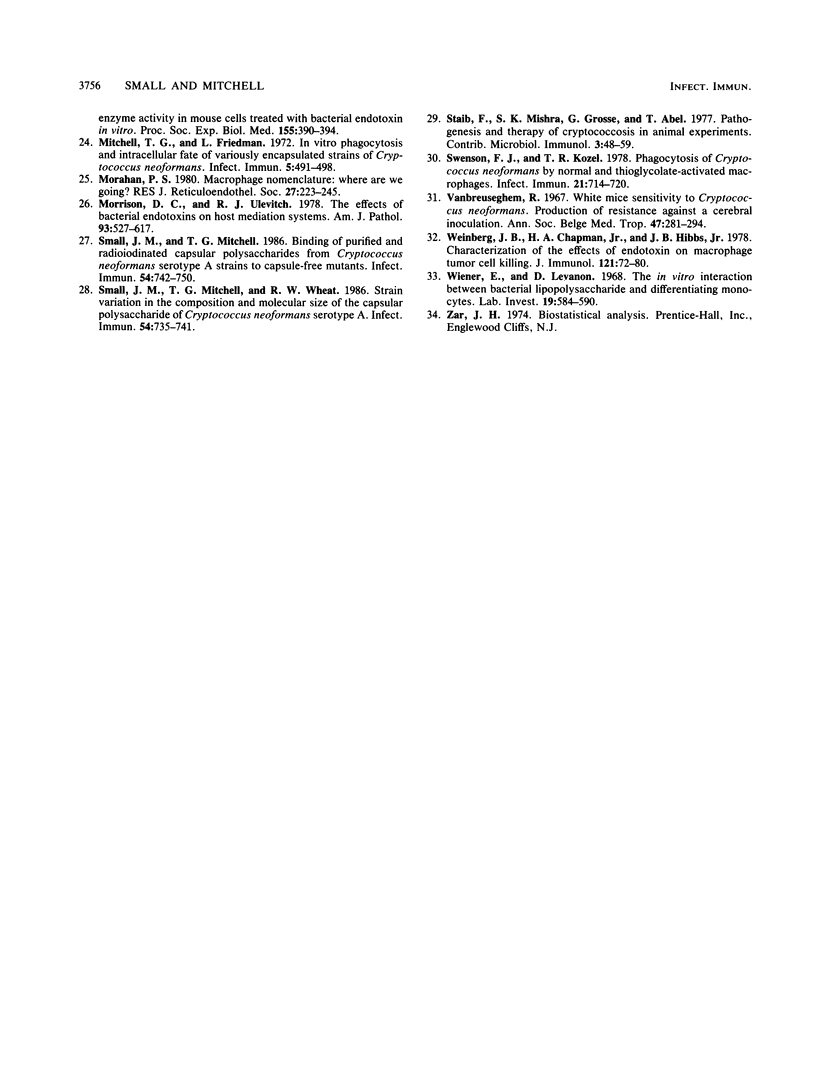Abstract
Strains of Cryptococcus neoformans vary in resistance to phagocytosis in vitro. The binding of isolated capsular polysaccharide (CPS) to a capsule-free mutant of C. neoformans confers resistance to phagocytosis. The importance of capsule composition to differences among strains in susceptibility to phagocytosis was evaluated. CPSs from five strains of C. neoformans serotype A, designated 6, 15, 98, 110, and 145, which had previously been isolated and characterized as to molecular size, composition, and binding properties, were evaluated for relative antiphagocytic potencies. In the presence of 5% normal isologous serum, murine thioglycolate-elicited peritoneal macrophages phagocytized (i.e., attached to or engulfed) 80% of 51Cr-labeled cells of C. neoformans 602, a capsule-free mutant. Added CPS inhibited the uptake of these yeast cells. CPS from strain 110 was most potent, followed in decreasing order of inhibitory activity by CPSs from strains 6, 145, 98, and 15. The presence of 100 micrograms of strain 110 CPS per ml reduced uptake of cells of strain 602 from 80 to 50%. CPS had no effect on the uptake of 51Cr-labeled Saccharomyces cerevisiae. Cells of strain 602 that were preincubated with CPS and then washed were more resistant to phagocytosis than nonpretreated control cells, indicating the importance of bound, not free, CPS. Added CPS did not affect the uptake of wild-type, encapsulated cells of C. neoformans. Addition of endotoxin had no effect on phagocytosis. CPSs from strains of C. neoformans serotype A varied widely in their abilities to inhibit the uptake of capsule-free cells. The antiphagocytic activity of CPS did not correlate with the ability to bind to capsule-free mutant but was somewhat related to the capsule size of the strain from which the CPS was isolated.
Full text
PDF





Selected References
These references are in PubMed. This may not be the complete list of references from this article.
- BAKER R. D., HAUGEN R. K. Tissue changes and tissue diagnosis in cryptococcosis; a study of 26 cases. Am J Clin Pathol. 1955 Jan;25(1):14–24. doi: 10.1093/ajcp/25.1.14. [DOI] [PubMed] [Google Scholar]
- Bennett W. E., Cohn Z. A. The isolation and selected properties of blood monocytes. J Exp Med. 1966 Jan 1;123(1):145–160. doi: 10.1084/jem.123.1.145. [DOI] [PMC free article] [PubMed] [Google Scholar]
- Bolaños B., Mitchell T. G. Phagocytosis of Cryptococcus neoformans by rat alveolar macrophages. J Med Vet Mycol. 1989;27(4):203–217. [PubMed] [Google Scholar]
- Bulmer G. S., Sans M. D. Cryptococcus neoformans. 3. Inhibition of phagocytosis. J Bacteriol. 1968 Jan;95(1):5–8. doi: 10.1128/jb.95.1.5-8.1968. [DOI] [PMC free article] [PubMed] [Google Scholar]
- Bulmer G. S., Sans M. D. Cryptococcus neoformans. II. Phagocytosis by human leukocytes. J Bacteriol. 1967 Nov;94(5):1480–1483. doi: 10.1128/jb.94.5.1480-1483.1967. [DOI] [PMC free article] [PubMed] [Google Scholar]
- Dykstra M. A., Friedman L., Murphy J. W. Capsule size of Cryptococcus neoformans: control and relationship to virulence. Infect Immun. 1977 Apr;16(1):129–135. doi: 10.1128/iai.16.1.129-135.1977. [DOI] [PMC free article] [PubMed] [Google Scholar]
- Farmer S. G., Komorowski R. A. Histologic response to capsule-deficient Cryptococcus neoformans. Arch Pathol. 1973 Dec;96(6):383–387. [PubMed] [Google Scholar]
- Fromtling R. A., Shadomy H. J., Jacobson E. S. Decreased virulence in stable, acapsular mutants of cryptococcus neoformans. Mycopathologia. 1982 Jul 23;79(1):23–29. doi: 10.1007/BF00636177. [DOI] [PubMed] [Google Scholar]
- Granger D. L., Lehninger A. L. Sites of inhibition of mitochondrial electron transport in macrophage-injured neoplastic cells. J Cell Biol. 1982 Nov;95(2 Pt 1):527–535. doi: 10.1083/jcb.95.2.527. [DOI] [PMC free article] [PubMed] [Google Scholar]
- Griffin F. M., Jr Roles of macrophage Fc and C3b receptors in phagocytosis of immunologically coated Cryptococcus neoformans. Proc Natl Acad Sci U S A. 1981 Jun;78(6):3853–3857. doi: 10.1073/pnas.78.6.3853. [DOI] [PMC free article] [PubMed] [Google Scholar]
- HASENCLEVER H. F., MITCHELL W. O. Virulence and growth rates of Cryptococcus neoformans in mice. Ann N Y Acad Sci. 1960 Aug 27;89:156–162. doi: 10.1111/j.1749-6632.1960.tb20138.x. [DOI] [PubMed] [Google Scholar]
- Kozel T. R., Cazin J. Nonencapsulated Variant of Cryptococcus neoformans I. Virulence Studies and Characterization of Soluble Polysaccharide. Infect Immun. 1971 Feb;3(2):287–294. doi: 10.1128/iai.3.2.287-294.1971. [DOI] [PMC free article] [PubMed] [Google Scholar]
- Kozel T. R., Gotschlich E. C. The capsule of cryptococcus neoformans passively inhibits phagocytosis of the yeast by macrophages. J Immunol. 1982 Oct;129(4):1675–1680. [PubMed] [Google Scholar]
- Kozel T. R., Hermerath C. A. Binding of cryptococcal polysaccharide to Cryptococcus neoformans. Infect Immun. 1984 Mar;43(3):879–886. doi: 10.1128/iai.43.3.879-886.1984. [DOI] [PMC free article] [PubMed] [Google Scholar]
- Kozel T. R., McGaw T. G. Opsonization of Cryptococcus neoformans by human immunoglobulin G: role of immunoglobulin G in phagocytosis by macrophages. Infect Immun. 1979 Jul;25(1):255–261. doi: 10.1128/iai.25.1.255-261.1979. [DOI] [PMC free article] [PubMed] [Google Scholar]
- Kozel T. R. Non-encapsulated variant of Cryptococcus neoformans. II. Surface receptors for cryptococcal polysaccharide and their role in inhibition of phagocytosis by polysaccharide. Infect Immun. 1977 Apr;16(1):99–106. doi: 10.1128/iai.16.1.99-106.1977. [DOI] [PMC free article] [PubMed] [Google Scholar]
- Kozel T. R., Pfrommer G. S., Guerlain A. S., Highison B. A., Highison G. J. Strain variation in phagocytosis of Cryptococcus neoformans: dissociation of susceptibility to phagocytosis from activation and binding of opsonic fragments of C3. Infect Immun. 1988 Nov;56(11):2794–2800. doi: 10.1128/iai.56.11.2794-2800.1988. [DOI] [PMC free article] [PubMed] [Google Scholar]
- Kozel T. R., Reiss E., Cherniak R. Concomitant but not causal association between surface charge and inhibition of phagocytosis by cryptococcal polysaccharide. Infect Immun. 1980 Aug;29(2):295–300. doi: 10.1128/iai.29.2.295-300.1980. [DOI] [PMC free article] [PubMed] [Google Scholar]
- McGaw T. G., Kozel T. R. Opsonization of Cryptococcus neoformans by human immunoglobulin G: masking of immunoglobulin G by cryptococcal polysaccharide. Infect Immun. 1979 Jul;25(1):262–267. doi: 10.1128/iai.25.1.262-267.1979. [DOI] [PMC free article] [PubMed] [Google Scholar]
- McGivney A., Bradley S. G. Enhanced lysosomal enzyme activity in mouse cells treated with bacterial endotoxin in vitro. Proc Soc Exp Biol Med. 1977 Jul;155(3):390–394. doi: 10.3181/00379727-155-39814. [DOI] [PubMed] [Google Scholar]
- Mitchell T. G., Friedman L. In vitro phagocytosis and intracellular fate of variously encapsulated strains of Cryptococcus neoformans. Infect Immun. 1972 Apr;5(4):491–498. doi: 10.1128/iai.5.4.491-498.1972. [DOI] [PMC free article] [PubMed] [Google Scholar]
- Morahan P. S. Macrophage nomenclature: where are we going? J Reticuloendothel Soc. 1980 Feb;27(2):223–245. [PubMed] [Google Scholar]
- Morrison D. C., Ulevitch R. J. The effects of bacterial endotoxins on host mediation systems. A review. Am J Pathol. 1978 Nov;93(2):526–618. [PMC free article] [PubMed] [Google Scholar]
- Small J. M., Mitchell T. G. Binding of purified and radioiodinated capsular polysaccharides from Cryptococcus neoformans serotype A strains to capsule-free mutants. Infect Immun. 1986 Dec;54(3):742–750. doi: 10.1128/iai.54.3.742-750.1986. [DOI] [PMC free article] [PubMed] [Google Scholar]
- Small J. M., Mitchell T. G., Wheat R. W. Strain variation in composition and molecular size of the capsular polysaccharide of Cryptococcus neoformans serotype A. Infect Immun. 1986 Dec;54(3):735–741. doi: 10.1128/iai.54.3.735-741.1986. [DOI] [PMC free article] [PubMed] [Google Scholar]
- Swenson F. J., Kozel T. R. Phagocytosis of Cryptococcus neoformans by normal and thioglycolate-activated macrophages. Infect Immun. 1978 Sep;21(3):714–720. doi: 10.1128/iai.21.3.714-720.1978. [DOI] [PMC free article] [PubMed] [Google Scholar]
- Vanbreuseghem R. White mice sensitivity to Cryptococcus neoformans. Production of resistance against a cerebral inoculation. Ann Soc Belges Med Trop Parasitol Mycol. 1967;47(4):281–294. [PubMed] [Google Scholar]
- Weinberg J. B., Chapman H. A., Jr, Hibbs J. B., Jr Characterization of the effects of endotoxin on macrophage tumor cell killing. J Immunol. 1978 Jul;121(1):72–80. [PubMed] [Google Scholar]
- Wiener E., Levanon D. The in vitro interaction between bacterial lipopolysaccharide and differentiating monocytes. Lab Invest. 1968 Dec;19(6):584–590. [PubMed] [Google Scholar]


